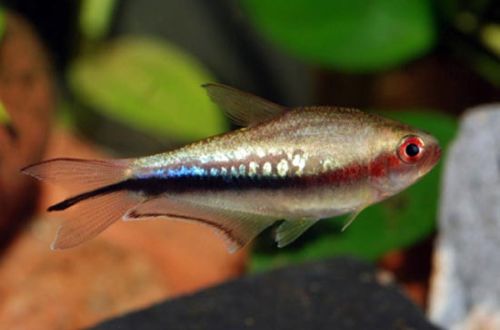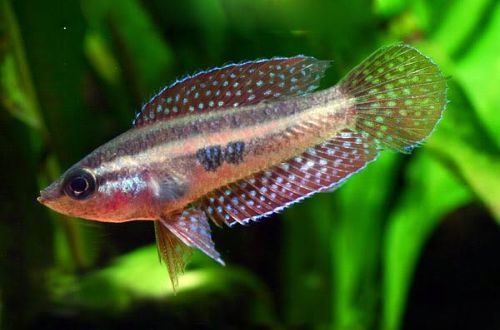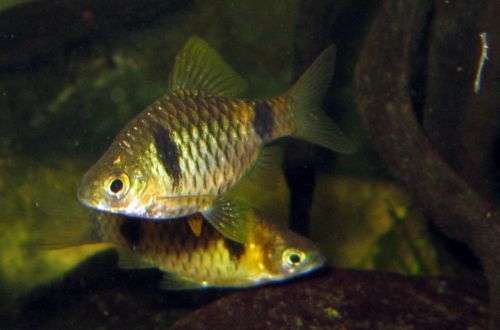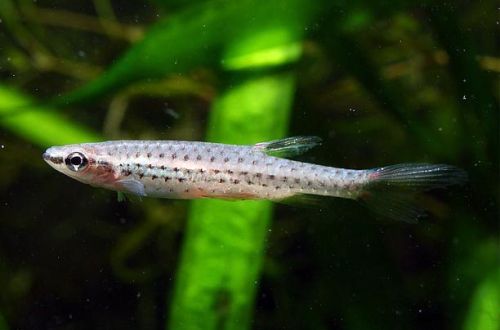
Rainbow Tetra
Rainbow Tetra or Rainbow Tetra, scientific name Nematobrycon lacortei, belongs to the Characidae family (Characinidae). The iridescent coloration of the fish is reflected in their name, although in general they are silvery. Easy to keep and breed, get along well with other non-aggressive species of similar size.

Contents
Habitat
Comes from South America. It is considered endemic to the San Juan River Basin, in the very west of Colombia. It is found in the upper reaches of rivers flowing among the dense equatorial forest.
Brief information:
- The volume of the aquarium – from 100 liters.
- Temperature – 20-28°C
- Value pH — 5.0–7.2
- Water hardness – 1–10 dGH
- Substrate type – sandy
- Lighting – subdued or moderate
- Brackish water – no
- Water movement is weak
- The size of the fish is up to 6 cm.
- Feeding – any food of suitable size
- Temperament – peaceful
- Content flocking from 8-10 individuals
Description
Adults reach a length of up to 6 cm. Males have red eyes and elongated anal, dorsal and caudal fins. At the tail, the central rays are strongly elongated, forming something like a “sword”. Females look more modest, fins are relatively short, eyes are blue-green. The main color is silvery with pink, green, blue tints. A wide dark stripe stretches along the body. The edges of the fin have a dark or reddish edging.
Food
Undemanding to the composition of food, they accept almost all types of popular food intended for aquarium fish. The daily diet may include dry food in the form of flakes, granules, as well as live or frozen brine shrimp, daphnia, small bloodworms.
Maintenance and care, arrangement of the aquarium
An aquarium with a volume of 100 liters or more, sufficient for a flock of 8–10 individuals, is considered optimal for long-term maintenance. The design is arbitrary, at the discretion of the aquarist. However, it has been noted that being in an environment that resembles their natural habitat, the fish show their best coloration. For decoration, it is recommended to use sandy soil, several snags, dense thickets of aquatic plants, including floating ones. The lighting is subdued.
If desired, you can add the leaves of some trees. In the process of decomposition, they release tannins, which give the water a chemical composition and color (brown), similar to that in which fish live in natural reservoirs. Read more in the article “Which tree leaves can be used in an aquarium.” In addition, decomposed leaves become an environment for the development of a colony of microorganisms, such as shoe ciliates – a valuable source of food for fry.
Successful keeping of the Rainbow Tetra depends on a number of factors. In addition to a balanced diet, it is essential to ensure stable water conditions within an acceptable range of temperatures and hydrochemical values (pH and dGH), as well as to control the concentrations of nitrogen cycle products (ammonia, nitrites, nitrates). Maintaining the desired stability is largely determined by the set of installed equipment and the regularity of the mandatory maintenance procedures for the aquarium. The latter include weekly replacement of part of the water with fresh water, timely removal of organic waste (feed residues, excrement), checking the water for compliance with the desired values, etc.
Behavior and Compatibility
Males are territorial and compete with each other for the attention of females, but this rarely leads to skirmishes, so the Rainbow Tetra can be classified as a peaceful species. It is desirable to maintain a group size of at least 8-10 individuals. The principle is simple – the more the better. Compatible with other non-aggressive fish of comparable size.
Breeding / breeding
Under favorable conditions, spawning occurs regularly and does not have any pronounced systemic character. Experienced aquarists keep males and females separately when breeding. Having chosen the brightest and largest fish, they are placed together, after which spawning is expected. If all else fails try with another pair.
The females scatter the eggs among the plants, and the male fertilizes them. There is no parental care for offspring. Moreover, adult fish pose a direct threat to their own fry, so fertilized eggs are removed.
The incubation period and further development of the fry should take place in a separate tank with identical water conditions to the main aquarium. Usually, it is equipped with a simple airlift filter with a sponge and a heater. There is no need for a separate light source. The fry appear after 24-36 hours, after another 4-5 days they begin to swim freely in search of food. During the first week, microscopic food, such as ciliates or specialized powdered foods, should be fed. As they grow, brine shrimp nauplii, etc., can become the basis of the diet.
Fish diseases
Diseases inherent in this particular species of fish were not noted. When kept in suitable conditions (high water quality, balanced diet, non-conflict neighbors, etc.), health problems are not observed. The most common cause of disease is the deterioration of conditions leading to immune suppression, which makes the fish susceptible to infections that are invariably present in the surrounding area. When the first signs of an illness are detected (lethargy, exhaustion, refusal of food, lowered fins, etc.), it is necessary to immediately check the main parameters of the water. Often, the restoration of acceptable living conditions contributes to self-healing, but if the fish is too weak or has received obvious damage, medical treatment will be required. For more information on symptoms and treatments, see the Aquarium Fish Diseases section.





